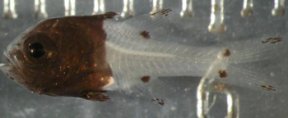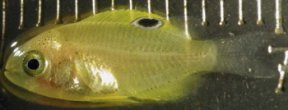Fishy Sounds
Baby fish may home in on reef noise to find a place to live.
Although coral reefs look peaceful, they’re noisy places. Shrimp make popping noises that sound like bacon frying in a pan. Fish click their jaws or make rumbling sounds as they swim around.
Such a loud, continuous racket may sound strange to snorkelers, but new experiments suggest that this reef noise attracts baby fish looking for a place to settle down.
 |
|
Coral reefs snap, crackle, and click with the calls of various residents, and baby fish appear to home in on those sounds. |
| PhotoDisc |
For a long time, biologists have wondered how reef fish find a home. Most reef fish spend the first part of their lives in open water. The baby fish, called larvae, are only about as big as a crumb.
Scientists used to think that, after hatching, larvae drifted wherever ocean currents took them, perhaps hundreds or thousands of miles away. The fish couldn’t control where they went. If the larvae were lucky, the currents carried them into a forest of coral where they could live.
It turns out that, although the larvae are small, they actually become pretty strong swimmers. With this skill, fish larvae might be able to control where they go. And, although little fish do venture into open water, they seem to stick closer to where they hatched than scientists had expected.
But, without a map of the ocean floor, how can these tiny critters find a reef to call home?
Sound can travel for long distances under water. So, Stephen Simpson of the University of Edinburgh and his coworkers proposed that baby fish can hear the racket made by reef creatures. If so, the fish could follow the noise to join the party.
To test their hypothesis, the scientists created a bunch of small, artificial reefs in the waters off Lizard Island in Australia’s Great Barrier Reef. In some coral clumps, they played recordings of fish and shrimp sounds throughout the night. In others, it was quiet.
 |
|
A member of the cardinalfish family. |
| © Science |
When the researchers checked back the next morning, they discovered that about twice as many young cardinalfish and damselfish had been lured to the noisy reefs as had come to the quiet reefs.
 |
|
A member of the damselfish family. |
| © Science |
So, like kids drawn by the shouts and laughter coming from a playground, baby fish seem to follow the noises of other reef dwellers to find a place where they want to be.—K. Ramsayer
Going Deeper:
Milius, Susan. 2005. Fish din: Reef clamor attracts young fish settlers. Science News 167(April 9):229-230. Available at http://www.sciencenews.org/articles/20050409/fob6.asp .
Click here to download a PowerPoint file that lets you hear some of the sounds of a coral reef. Courtesy of Stephen Simpson of the University of Edinburgh.
You can learn more about how reef noise may guide young fish home at www.cpa.ed.ac.uk/release/?FMRecord=1165 (University of Edinburgh).







